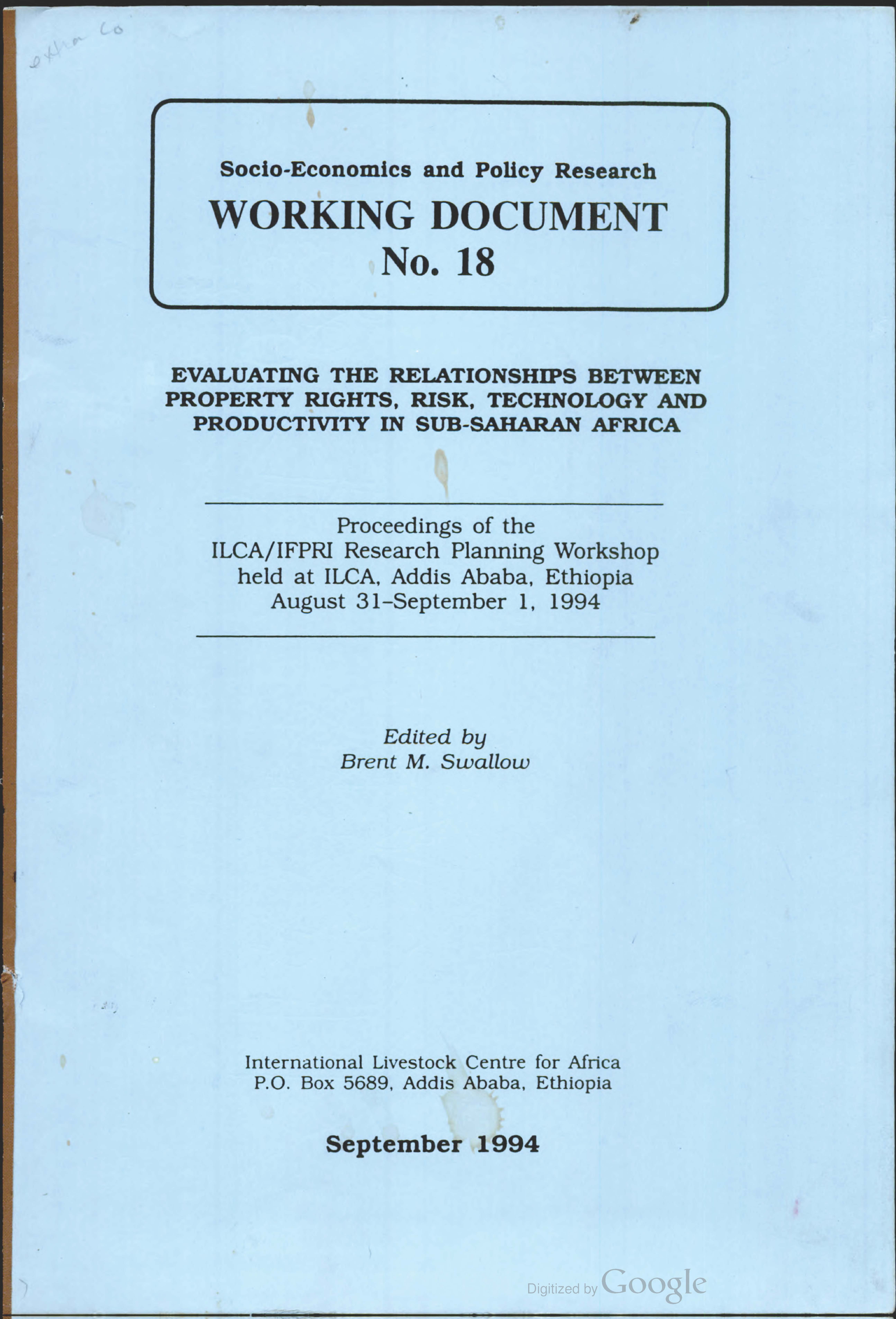Shifting Cultivation in Thailand: Its Current Situation and Dynamics in the Context of Highland Development
ABSTRACTED FROM IIED WEBSITE INTRODUCTION: One of the outputs of a research project considering shifting cultivation in Thailand, Lao PDR and Vietnam. It considers the dynamics of shifting cultivation and alternative land use systems in the context of highland development in Thailand, gathered in order to provide up-to-date information to policymakers. The study includes examination of national policies relating to highland areas and the impacts of such policies on local communities and land use patterns.
Land tenure and agricultural productivity in Ethiopia
This research is being undertaken as an ILCA project with support from the Rockefeller Post-Doctoral Fellowship Programme. There are three objectives. One objective is very similar to that of the World Bank and Niger studies: to determine the effects of land tenure on investment, productivity and efficiency in crop-livestock systems in the Ethiopian highlands.
Property rights and soil fertility management in Niger
This research was undertaken as a Ph.D. dissertation (Stanford University) in conjunction with the ILCA programme in Niamey, Niger. The objective of the research was similar to that of the World Bank studies: to test how land tenure affects land-improving investment, agricultural productivity and resource management. The standard hypothesis is that land tenure that is non-exclusive insecure or non-transferable will lead to under-investment and depressed factor mobility.
Food and agriculture in Africa: ECA/FAO Agriculture Division
The paper suggests a way forward to increase considerably the food-production in the Sub-Saharan African countries which have perpetually been suffering from acute shortage of food grains. Contrary to observed trends in most parts of the world, food production in Sub-Saharan Africa has failed miserably to keep pace with the growing population. Consequently, the region has been one of the most famine-prone regions on the planet. There is a lot to be learnt from the experience of many of the Asian countries who have made it on the food front inspite of equally difficult population pressures.
Multi-scale characterization of inland valley agro-ecosystems in West Africa.
Inland valleys are defined as the upper reaches of river systems. These include valley bottoms and minor floodplains,their hydromorphic fringes and upland slopes and crests. These occupy 22-52 million ha of land in W. Africa and although of good agricultural potential are only marginally used. An agro-ecological characterization developed in the Cte d'Ivoire, is outlined on 4 levels: macro (1:1 000 000-1:5 000 000), reconnaissance (1:100 000-1:250 000), semi-detailed (1:25 000-1:50 000) and detailed (1:5000-10 000).
Etude sur l'harmonisation de politiques agricoles dans les états membres de l'organisation du bassin de la Kagera - OBK
L'étude sur l'harmonisation des politiques agricoles dans les Etats membres de l'Organisation du Bassin de la Rivière KAGERA répond donne a cette nécessité de fournir une information sur la situation de l'agriculture dans cette sous-région de l'OBK à toute la Communauté internationale (promoteurs/operateurs économiques, bailleurs de fonds bilatéraux et multilatéraux; institutions financières,...) pour lui permettre d'examiner le genre d'assistance et le volume d'intervention en faveur du développement du secteur agricole qui constitue une grande priorité des Etats de cette sous-région.
Uruguay round agreement : a preliminary assessment (agriculture)
This note is divided into three sections. The first section describes the Final Act analyzing the details of the agreement on market access, domestic support, export subsidies, the special and differential treatment of the developing countries including the Decision referred to in (iii) above; and a brief look at other sectors.
Land suitability evaluation for agriculture around Timau area - Heru District
A study was conducted of about 8000 ha around Timau area
in Meru District to evaluate its land suitability for
agriculture. A semi detailed soil survey was carried out to
classify and map the different soil units. Based on the
relevant land qualities of each Soil Unit and physiography
they were seperated in 15 Soil Mapping Units for the various
Land Utilization Types with land use recommendations given.
The following land qualities were rated and used to assess the
suitability of each Soil Mapping Unit: soil water retention,
Food and agriculture in Africa
The first four years of the 1990s indicate that African economies have grown by a mere 1.5 per cent per annum worse than during the "lost decade" of the 1980s when Africa's economic annual growth rate was on average 1.8 per cent during the period 1980-1990. This growth is barely half of the rate of growth of Africa's population and is well below the annual average growth target of 4 per cent set by the World Food Conference in 1974, and still worse than the 6 per cent set in the United Nations New Agenda for the Development of Africa in the 1990s.
Real and ideal water rights: the prospects for water-rights reform in Israel, Gaza, and the West Bank
The ideal water contract for a heterogeneous population of users is a prioritized right that is fully vested and fully tradable. A set of tradable, prioritized rights contracts will span the same space as the Debreu contingent commodities. Therefore, they lead to a competitive equilibrium that is Pareto optimal. Equal sharing of water shortfalls does not have this property.Existing water policies in Israel and the Disputed Territories are not characterized by an efficient set of water contracts.








